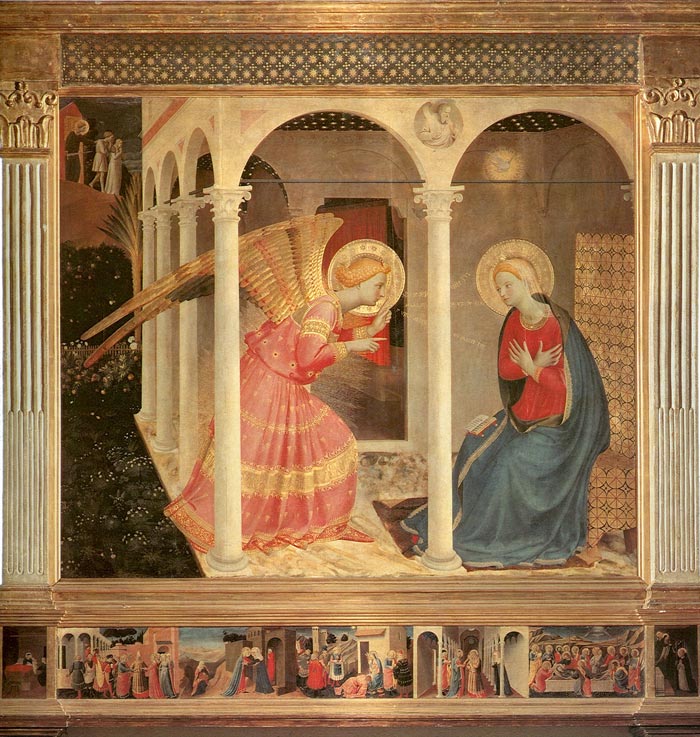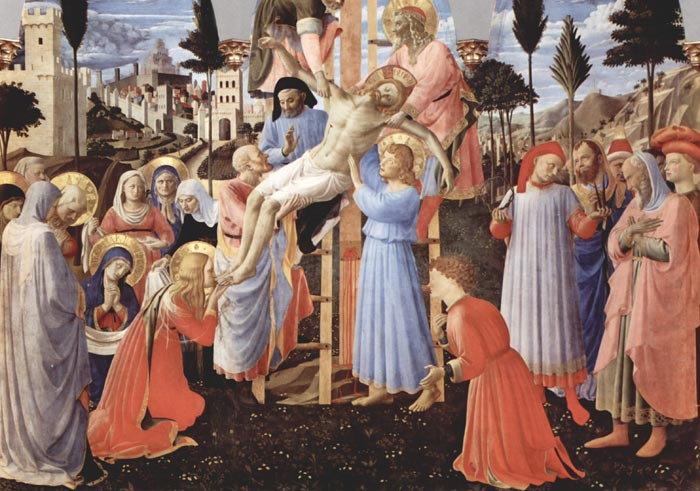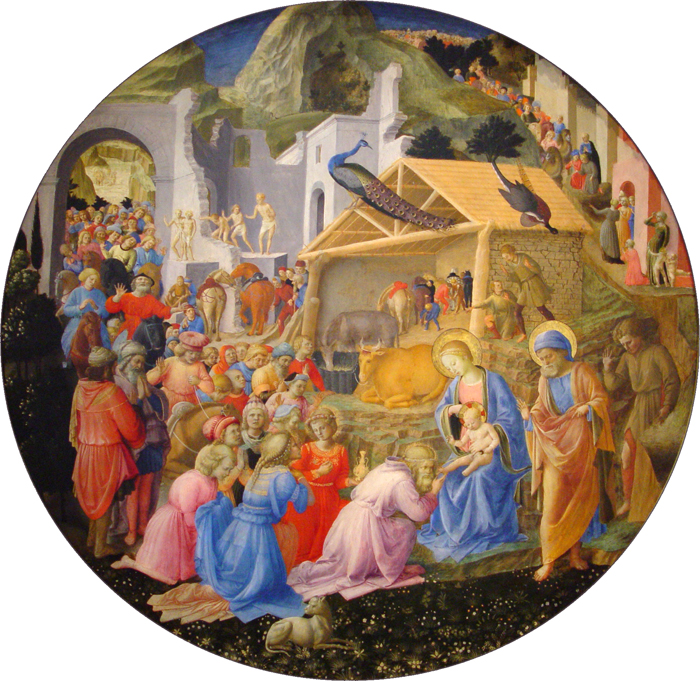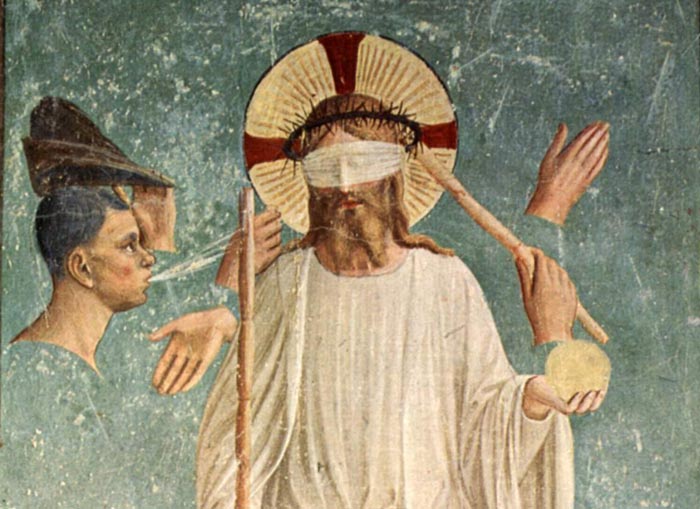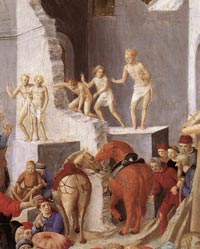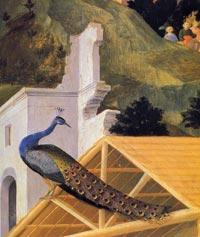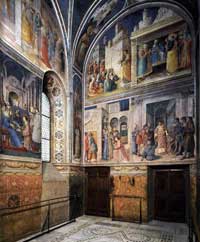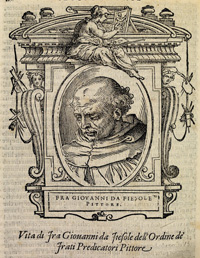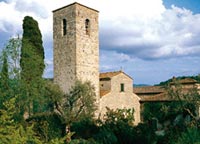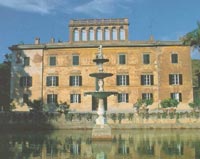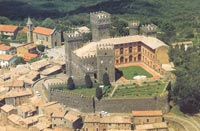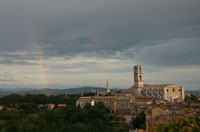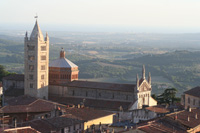| |
|
Fra Angelico (c. 1395 – February 18, 1455), born Guido di Pietro, was an Early Italian Renaissance painter. Born in the countryside north of Florence, Guido di Pietro was already an established artist when he joined the Dominican order sometime between 1419 and 1422, taking for himself the name Fra Giovanni. Known in Italy as il Beato Angelico, he was known to his contemporaries as Fra Giovanni da Fiesole. In Giorgio Vasari's Lives of the Artists, written prior to 1555, he was already known as Fra Giovanni Angelico .
His prominence as an artist was challenged in Florence only by the brief and meteoric career of Masaccio (1401–1428), many of whose innovations Angelico anticipated in his own, still little-understood early works. By the time Masaccio left Florence for Rome in 1427, Angelico was indisputably the leading painter in Tuscany, a position he maintained for nearly thirty years, eclipsing the reputations of such gifted artists as Fra Filippo Lippi (1406–1469), Domenico Veneziano (ca. 1410–1461), and even the young Piero della Francesca (ca. 1406/12–1492).
For all his fame and popularity, there are few more elusive personalities in art than Fra Angelico. So completely did the man and artist live within his monastic cowl and robe, effacing himself within the disciplines of monastic life, that his early life, training and personality are only guesswork. He left no written record of his own. His biographer, Painter-Historian Giorgio Vasari, wrote nearly a century after Fra Angelico's death. [1]
Through Fra Angelico's pupil Benozzo Gozzoli's careful portraiture and technical expertise in the art of fresco we see a link to Domenico Ghirlandaio, who in turn painted extensive schemes for the wealthy patrons of Florence, and through Ghirlandaio to his pupil Michelangelo and the High Renaissance.
|
|
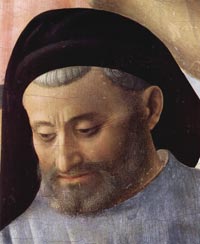 This face in the "Deposition of Christ" is thought to be a self portrait of Fra Angelico. This face in the "Deposition of Christ" is thought to be a self portrait of Fra Angelico.
Others identify the man as Michelozzo di Bartolomeo Michelozzi, an Italian architect and sculptor. |
The Coronation of the Virgin is a painted retable, perhaps commissioned by the Gaddi family, for one of the altars of the monastery of San Domenico in Fiesole, where the artist later served as prior. The studied perspective and the physicality of the figures attest to the influence of Masaccio on the young Fra Angelico. Fra Angelico executed three altarpieces for the church and convent of San Domenico in Florence. They not only demonstrate his mastery in the 1420s but are suffused with Dominican ideals, most notably the veneration of Christ and Mary.
The San Domenico Altarpiece was the first painting that Angelico painted for the church, it was followed by the Annunciation and the Coronation of the Virgin. The Altarpiece represents the Virgin and Child surrounded by angels and flanked by four saints: Thomas Aquinas, the Order's greatest scholar; Barnabus, patron saint of Barnaba degli Agli, benefactor of the convent, to whom the church was jointly dedicated; Dominic, founder of the Order; and Peter Martyr, the Order's first martyr and most eloquent preacher. originally conceived as a triptych, it was united into a single panel and its background repainted by the artist Lorenzo di Credi in 1501, when the church was modernized.
The Linaioli Tabernacle (c. 1433) altarpiece comes from the Church of San Domenico in Fiesole, and was sold and taken to Spain in 1611. The main painting is the Annunciation which repeats a design Fra Angelico also used in an Annunciation in Cortona and in another at the head of the stairs to the dormitory of his monastery, San Marco in Florence. There are five small predella pictures below the Annunciation, painted on the same panel, depicting the story of the Virgin.
The altarpiece Coronation of the Virgin painted by Fra Angelico for the Observant Dominican church outside of Fiesole (now in the Louvre) represents the court of heaven assembled in celebration and contemplation of the Virgin.
This altarpiece, exhibited now in the Musée du Louvre together with its seven predella pictures, was executed for the church San Domenico in Fiesole, and it is one of the most famous of Fra Angelico's works. It is a good example of the painter's art of tempera painting with fresh colours that have not changed. Fra Angelico departs markedly from his usual methods of space projection, but this can be explained by the extreme difficulty of integrating so complex a composition as a traditional Coronation, into the type of space he had recently employed. The whole, although still a heavenly scene, is set on terra firma. The sky is a realistic blue and not gold. The very low view-point enables the assembled saints and angels to be placed in a series of tiers without obscuring one another. The figures in the foreground kneel so as not to attract undue emphasis. Mary Magdalen holds out her jar of oil, marking the central axis.
The company of prophets and saints is carefully selected and arranged to argue a case for the status and authority of the recently established observance. Envisioning the realm of the divine, it also shows modes of viewing: presenting examples of devotional behaviour, which were addressed to a range of viewers. Hierarchical as an image, this painting offers a case for the study of how devotional viewing was understood in relation to social and institutional hierarchies in early fifteenth-century Florence. A brief review of the painting's critical fortunes also shows how art history creates ways of seeing that can significantly alter the status and interpretation of a given work.
On the predella the story of San Domenico is depicted.
Fra Angelico | The Coronation of the Virgin ( 1430 - 1432) |
|
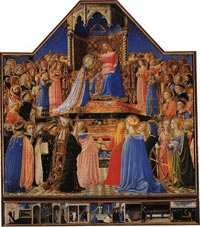
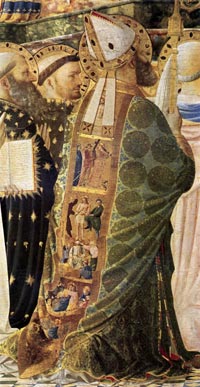
Coronation of the Virgin (details), Musée du Louvre, Paris. St Nicholas's cope shows several scenes from the Passion, including the Betrayal, Mocking, and Flagellation.
|
|
|
|
| |
|
The Cortona Altarpiece (The Annunciation, 1433-34)
|
|
Fra Angelico, Annunciation, c. 1432-1434, tempera on panel, Cortona, Museo Diocesano
|
The painting is a repetition of the main panel of the Prado Altarpiece in a more refined architectural setting. The altarpiece is the work of Fra Angelico with an intervention of his collaborators only in the predella pictures.
This altarpiece, called Cortona Altarpiece (to be distinguished from the Cortona Triptych) and consisting of the Annunciation and six small predella pictures, was executed for the church San Domenico at Cortona, and in later centuries, probably during the French occupation, was transferred to the church Ges?, presently the Museo Diocesano.
In a loggia of columns and arches, the angel appears to Mary. Shown in profile, he occupies the larger part of the painting, his richly painted wings extending out through the colonnade, their upper tips marking the centre of the picture. He declaims to the Virgin, 'the Holy Ghost shall come upon thee, and the power of the highest shall overshadow thee' (Luke 1, v. 35). She, demure, with a dove fluttering above her head in a burst of golden light, inclines towards him and responds, 'Behold the handmaid of the Lord; be it unto me according to thy word' (Luke 1, v. 38). Beyond them the picture space extends into the Virgin's chamber, and further, hidden space is hinted at by the bed curtain there which serves also to set off Gabriel's nimbus.
Outside the loggia is a delicately painted garden, enclosed by a palisade, symbolic of Mary's virginity. Carved in a roundel above the centre column is a half-length effigy of Isaiah, who had prophesied the birth of a child to a virgin. The pink entablature of the loggia points to the second reference to the Old Testament, in the top left corner, where Adam and Eve are expelled from Paradise.
In the predella below the Annunciation, near the two farthest edges, two scenes are painted. The first represent the Birth of the Virgin, the other The Virgin Consigns the Habit to St Dominic. There are five central scenes of the life of the Virgin, one after the other without interruption, namely (from the left). Marriage of the Virgin, The Visitation, Adoration of the Magi, Presentation of Jesus at the Temple, Death of the Virgin.
Undoubtedly Angelico's first truly great painting, this Annunciation formed a prototype for a noble line of derivatives.
Art in Tuscany | The Cortona Altarpiece (The Annunciation), 1433-34]
|
|
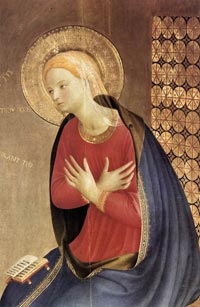 |
|
|
|
Deposition from the Cross (Pala di Santa Trinità), 1437-40
|
|
Fra Angelico, Deposition from the Cross (Pala di Santa Trinità), 1437-40, Museo di San Marco, Florence
|
| |
|
|
The altarpiece, one of the most grandiose of the Quattrocento altars, was executed after the decision of Cosimo de' Medici in 1438 to transfer to Cortona the triptych which served as main altar of the convent church. It depicts, in the front, the kneeling Saints Cosmas and Damian, then in the second row, from the left: Saints Lawrence, John the Evangelist, Mark, Dominic, Francis and Peter the Martyr. It is assumed that the figure of St Cosmas is the likeness of Cosimo de' Medici. In the lower center a Crucifixion with golden background can be seen.
Fra Angelicos Deposition from the Cross is by no means a straightforward recitation of the biblical narrative. At the center, Joseph of Arimathaea, Nicodemus, and the young Saint John the Evangelist, all haloes, lower the lifeless body of Christ. Two unidentified gentlemen, sometimes considered portraits, also participate. At far left Fra Angelico has depicted the many women who had followed the Via Crucis procession from Jerusalem, including the three Maries. Two other holy women in this group who have halos have never been identified. There are no textual of pictorial precedents for the group of worshipers, at right, who contemplate the event and sagely discuss the crown of thorns and the three nails. The young man kneeling in the foreground is believed to represent the Blessed Alessio degli Strozzi, a holy ancestor of Palla Strozzi, the humanist who commissioned this altarpiece for the sacristy of Santa Trinita.
Art in Tuscany | Fra Angelico, Deposition from the Cross
|
|
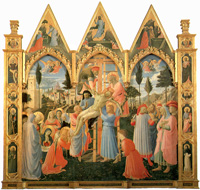
Fra Angelico, Deposition from the Cross (Pala di Santa Trinità), 1437-40, Museo di San Marco, Florence |
|
|
|
Fra Angelico, The Mocking of Christ (1439-43)
|
|
Fra Angelico, The Mocking of Christ (detail), with the Virgin and Saint Dominic, 1439-1443, fresco, Cell 7, Convent of San Marco, Florence(1439-43)
|
Much of Angelico's enduring popularity rests on his frescoes—especially those painted in the dormitory cells at the convent of San Marco in Florence.
The series of frescoes that Fra Angelico painted for the Dominican friars at the Convento di San Marco in Firenze, realise the advancements made by Masaccio and carry them further. Away from the constraints of wealthy clients and the limitations of panel painting, Fra Angelico was able to express his deep reverence for his God and his knowledge and love of humanity. The meditational frescoes in the cells of the convent have a quieting quality about them. They are humble works in simple colours. There is more mauvish-pink than there is red while the brilliant and expensive blue is almost totally lacking. In its place is dull green and the black and white of Dominican robes. There is nothing lavish, nothing to distract from the spiritual experiences of the humble people who are depicted within the frescoes. Each one has the effect of bringing an incident of the life of Christ into the presence of the viewer.
Fra Angelico concentrated on the simple devotional images required by his fellow monks for their meditations and prayers. The results, seen in the six cells definitely painted by Fra Angelico, represent Fra Angelico at his strongest and purest. To portray The Mocking of Christ, he painted a regal, blindfolded Christ figure crowned with thorns. The throng of jeering soldiery appear only as a group of disembodied hands and a loutish head, cap raised in sarcasm, spitting upon Christ. By abstracting all but the essential central image, Fra Angelico makes the eye travel through a curve of space to return endlessly to its starting point—the perfect movement theologians ascribe to the contemplative soul.
The contemplative restraint of the San Marco frescoes is nowhere better illustrated than in The Mocking of Christ. This is the fresco on the wall of Cell 7 of the Convento di San Marco in Firenze. Rather than paint Christ's humiliations in their full violence in a complex narrative work, they are reduced to a series of iconographic symbols. In doing this Angelico was drawing on established trecento precedents.
In a plain-walled room Christ sits on a dais in a luminous white robe and tunic. The great slab of white marble beneath Him adds to the air of radiant whiteness surrounding Him. He is blindfolded, with a crown of thorns about his head. Behind Him hanging from a plain frieze is a screen on which are painted the emblems of his indignities: the head of the spitting soldier, the hands of the buffeters, the hand and stick forcing the thorns down on his head. On a low step at the front of the picture sit the Virgin and St Dominic. Neither regard Christ but sit with their backs turned towards him in poses of intense meditation - the depth of meditation that the frescoes were designed to assist each friar to attain.
Fra Angelico | Frescoes in the Convento di San Marco (1438-50) |
|
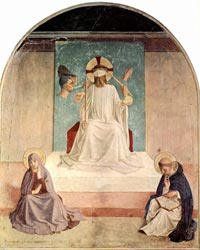
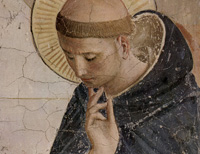
|
|
|
|
Fra Filippo Lippi and Fra Angelico, Adoration of the Magi (c. 1445)
|
|
Fra Filippo Lippi and Fra Angelico, Adoration of the Magi (detail), c. 1445, tempera on wood, National Gallery of Art, Washington
|
This tondo has long been the subject of scholarly debate over its authorship which has oscillated between Fra Filippo Lippi and Fra Angelico. It was painted for Cosimo de' Medici, or at least we know it was in the Medici Palace according to an inventory taken in 1492 where it was listed as by Fra Angelico.
Following the three kings a splendid procession, symbolizing all the races of mankind, waits to pay homage to the new-born Christ. The peacock is a symbol of the Resurrection. Some scholars believe that Fra Angelico laid out the composition and painted the Virgin and Child and at least some of the figures at the upper right; then his associate and fellow monk Fra Filippo Lippi completed the work.
This brilliantly colored, richly decorated circular panel presents a splendid vision of the arrival of the Magi, accompanied by a courtly entourage. A 1492 inventory of Lorenzo de' Medici's estate possibly identifies this picture as the most valuable in the collection of the powerful Florentine family, and attributes it to Fra Angelico. The Adoration of the Magi actually appears to be the product of two artists; Fra Angelico may only have started the altarpiece, the greatest part of the work having been taken up by Fra Filippo Lippi.
Fra Angelico was a Dominican known for his great monastic devotion; his saintly deportment is mirrored in the quiet piety of his paintings. The representation of the Virgin Mary here characterizes his style in the pure, simple form of her head and the gentle refinement of her features. Fra Filippo's earthy style appeals to the viewer in the portrayal of massive forms and well-articulated figures. In the Adoration, the richly attired wise men and their attendants, as well as the broad-faced Joseph beside the Virgin, are usually attributed to him.
While several elements of the painting can be seen as symbolic – for example, the peacock was considered a symbol of immortality – the Adoration can also simply be appreciated for its sparkling color, delightful details, and festive gaiety. [2] |
|
|
|
Armadio degli Argenti
|
The Basilica della Santissima Annunziata (Basilica of the Most Holy Annunciation) is a Roman Catholic minor basilica in Florence and the mother church of the Servite order. It is located at the northeastern side of the Piazza Santissima Annunziata.
n 1448, according to an early chronicle, Fra Angelico received from Piero de Medici, Cosimo's son, the prestigious assignment to decorate the doors of a silver treasury for the new oratory to be constructed near the chapel of the Santissima Annunziata in the church of the same name. Fra Angelico was commissioned for a massive painted cabinet to protect the precious silver votive offerings at Santissima Annunziata, among the most venerable churches in Florence.
The Armadio degli Argenti (Silver Chest) may have been the most visible of the friar's work by virtue of the site for which it was made. Santissima Annunziata was the motherhouse of the Servites, founded by St Filippo Benizzi (c. 1233-1285), the only religious order that originated in Florence. The sacrality of the church was augmented further when, as legend recounted, an angel completed the fresco of the Annunciation in 1252. By the early fifteenth century, the Annunciation had become the centre of a major cult, receiving donations of precious silver. In the late 1440s, Michelozzo renovated Santissima Annunziata at the behest of Piero de' Medici to accommodate the throngs of worshippers who flocked to behold the sacred image. To safeguard the silver offerings to the Annunciation, Piero commissioned a wooden cabinet, the movable shutters of which Fra Angelico painted.
Fra Angelico's series depicting scenes from the life of Christ consisted of 40 paintings of equal size (38,5 x 37 cm) and one additional double-sized painting. From the 41 paintings 6 were lost during the centuries. From the 35 paintings conservated in the Museo di San Marco 3 can be attributed to Baldovinetti, all the others are the work of Fra Angelico.
In this scene, Herod, with crown and sceptre, watches from above the infanticide he has ordained. The sinister, dark-clad soldiers pour through the archway wielding black daggers against the children. The mothers, shown in a great variety of terrified postures and with looks of horror, attempt to protect their infants, but to no avail.
Art in Tuscany | Fra Angelico | Paintings for the Armadio degli Argenti (1451-52) |
|
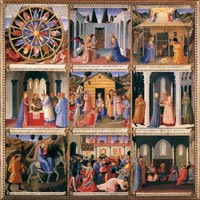
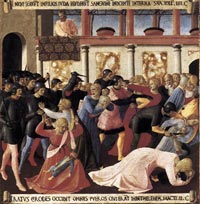
|
|
|
|
The sixteen prophets are shown seated, tier upon tier, in a tribune of judgment on Christs proper left side. The gothic ribbing of the vault was an almost insurmountable obstacle to the artists efforts to make a unified conception, and the necessity of arranging his figures inside triangular divisions is uncomfortably apparent. The rigidity of the prophets is slightly relieved by a certain amount of interaction within the group, especially among the nine that comprise the apex of the pyramid. The fresco mainly appeals for its luminous enamel-like colors, which have been liberated from much overpainting by the recent cleaning and restoration. In the corresponding vane on the other side of Christ, the Virgin is shown in the midst of the Apostles. This triangular section of fresco was designed by Fra Angelico in the summer of 1447, but only painted by Luca Signorelli fifty years later. |
|
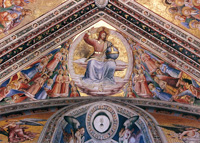 Fra Angelico, Sixteen Prophets, Chapel of Saint Brizio, Duomo, Orvieto
|
The Chapel of Nicholas V (Cappella Niccolina) is the only surviving fresco cycle of the four executed by Fra Angelico during his half decade of intense activity of papal service in Rome, from 1445 to 1449. By February 18, 144S, Fra Angelico had already begun work on these paintings, which completely fill the small secret chapel used by Nicholas V to celebrate Mass in private.
The chapel is located in the Tower of Innocent III, in the most ancient part of the Apostolic Palace. The walls were decorated by Fra Angelico with images of two of the earliest Christian martyrs; the upper level has Episodes from the Life of St. Stephen, and the lower one Scenes from the life of St. Laurence. The vault is painted blue, decorated with stars, and features figures of the Four Evangelists in the corners. The pilasters are decorated with the eight Doctors of the Church.
Under the pontificate of Nicholas V (1447-55) the Vatican became a court of the muses. The pope chief interest in the realm of arts was the embellishment of Rome. Fra Angelico took up his work in the Vatican for painting the pope's private chapel. The Cappella Niccolina is on the second floor of the Palazzo Vaticano (now part of the Vatican Museums). Three walls are covered with frescoes representing scenes from the lives of St Stephen and St Lawrence, two archdeacons who had been widely venerated in Rome since the early Middle Ages. The fresco on the altar wall (the south wall) had been destroyed. According to Vasari, this wall was adorned with an Entombment of Christ by Fra Angelico.
Fra Angelico | Frescoes in the Cappella Niccolina of the Palazzi Pontifici in Vatican (1447-49)
|
|
|
| |
|
|
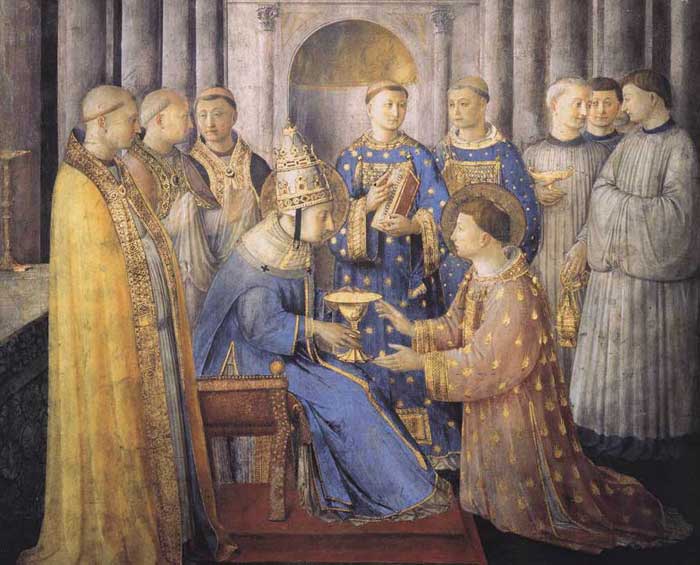 |
Fra Angelico, St. Peter Consacrates St. Lawrence as Deacon, Cappella Niccolina, Palazzi Pontifici, Vatican, View of the chapel
|
|
|
| |
|
Fra Angelico died in Rome on 18 February, 1455. An epitaph that was probably written by the humanist Lorenzo Valla praises the artist with these words, "Here lies the venerable painter Fra Giovanni of the Order of Preachers. Let me not be praised because I was another Apelles, but because I rendered ali my wealth to (what is) yours, O Chrise some (of my) works remain on earth, others in heaven. I first saw the light of the world in the city of Florence, the flower of Etruria."
|
The Coronation of the Virgin ( 1430 - 1432)
Last Judgement (c. 1431)
Deposition from the Cross (Pala di Santa Trinità), 1432-1434
The Linaioli Tabernacle, 1433
The Cortona Altarpiece (The Annunciation), 1433-34
The San Marco Altarpiece 1438-1440
Frescoes in the Convento di San Marco (1438-50) The Mocking of Christ (1439-43)
Frescoes in the Cappella Niccolina of the Palazzi Pontifici in Vatican (1447-49)
Paintings for the Armadio degli Argenti (1451-52)
|
 |
|
|
The Project Gutenberg EBook of Fra Angelico, by J. B. Supino
Fra Angelico Exhibition at the Metropolitan Museum of Art, (October 26, 2005–January 29, 2006).
This first major exhibition of Fra Angelico’s work since the quincentenary exhibition of 1955 in Florence — and the first ever in the USA — reunites approximately 75 paintings, drawings, and manuscript illuminations covering all periods of the artist’s career, from ca. 1410 to 1455. Included are several new attributions and paintings never before exhibited publicly, as well as numerous reconstructions of dispersed complexes, some reunited for the first time. An additional 45 works by Angelico's assistants and closest followers illustrate the spread and continuity of his influence into the second half of the 15th century.
Learn more about this exhibition | www.metmuseum.org
View images from this exhibition | www.metmuseum.org
Bernard Berenson, A Sienese painter of the Franciscan legend, John Lane Co., 1909, University of Michigan
Christiansen, Keith. "Fourteenth-Century Italian Altarpieces." The Metropolitan Museum of Art Bulletin, v. 40, no. 1 (Summer, 1982) | PDF
The Theater: The Bearers of Gifts | www.time.com
Encyclopedia Britannica complete article on Fra Angelico | The full version of the article is available only if you follow this link.
Giorgio Vasari | Lives of the Most Eminent Painters Sculptors and Architects, Fra Angelico | Detailed biography of the artist
|
|
|
 |
|
|
[1] Within his lifetime or shortly thereafter he was also called Il Beato (the Blessed), in reference to his skills in painting religious subjects. In 1982 Pope John Paul II conferred beatification, in recognition of the holiness of his life, thereby making this title official. Fiesole is sometimes misinterpreted as being part of his formal name, but it was merely the name of the town where he took his vows, used by contemporaries to separate him from other Fra Giovannis. He is listed in the Roman Martyrology as Beatus Ioannes Faesulanus, cognomento Angelicus—"Blessed Giovanni of Fiesole, nicknamed Angelico".
Vasari's principal sources were a pious Dominican eulogy and the memories of an ancient monk, Fra Eustachio. with whom Vasari often gossiped at Florence's convent of San Marco. From such accounts, Vasari drew the picture of Fra Angelico as a painter who "never took up his brush without first making a prayer. He never made a crucifix when the tears did not course down his cheeks . . ." Some later historians have doubted this picture of Fra Angelico in a state of religious ecstasy. The evidence in his painting points far more to a man who was the soul of patience and mildness, but calm, even cool, in temperament. Probably English Art Historian John Pope-Hennessy comes closest to the mark: "For all the translucent surface of his paintings, for all his rapturous pleasure in the natural world, there lay concealed, within Angelico's artistic personality, a Puritan faithful to his own intransigent ideal of reformed religious art."
Artistic legacy | Through Fra Angelico's pupil Benozzo Gozzoli's careful portraiture and technical expertise in the art of fresco we see a link to Domenico Ghirlandaio, who in turn painted extensive schemes for the wealthy patrons of Florence, and through Ghirlandaio to his pupil Michelangelo and the High Renaissance. Apart from the lineal connection, superficially there may seem little to link the humble priest with his sweetly pretty Madonnas and timeless Crucifixions to the dynamic expressions of Michelangelo's larger-than-life creations. But both these artists received their most important commissions from the wealthiest and most powerful of all patrons, the Vatican.
When Michelangelo took up the Sistine Chapel commission, he was working within a space that had already been extensively decorated by other artists. Around the walls the Life of Christ and Life of Moses were depicted by a range of artists including his teacher Ghirlandaio, Raphael's teacher Perugino and Botticelli. They were works of large scale and exactly the sort of lavish treatment to be expected in a Vatican commission, vying with each other in complexity of design, number of figures, elaboration of detail and skilful use of gold leaf. Above these works stood a row of painted Popes in brilliant brocades and gold tiaras. None of these splendours have any place in the work which Michelangelo created. Michelangelo, when asked by Pope Julius II to ornament the robes of the Apostles in the usual way, responded that they were very poor men.
Within the cells of San’Marco, Fra Angelico had demonstrated that painterly skill and the artist's personal interpretation were sufficient to create memorable works of art, without the expensive trappings of blue and gold. In the use of the unadorned fresco technique, the clear bright pastel colours, the careful arrangement of a few significant figures and the skilful use of expression, motion and gesture, Michelangelo showed himself to be the artistic descendant of Fra Angelico. Frederick Hartt describes Fra Angelico as "prophetic of the mysticism" of painters such as Rembrandt, El Greco and Zurbarán.
See also Frederick Hartt, A History of Italian Renaissance Art, Thames & Hudson, 1970.
|
|
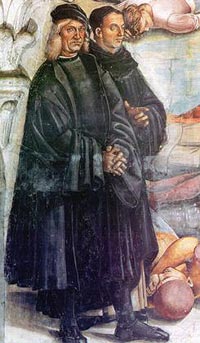 Posthumous portrait of Fra Angelico by Luca Signorelli, detail from Deeds of the Antichrist fresco (c.1501) in Orvieto Cathedral Posthumous portrait of Fra Angelico by Luca Signorelli, detail from Deeds of the Antichrist fresco (c.1501) in Orvieto Cathedral
|
| This page incorporates text from the article Angelico, Fra by William Michael Rossetti, in the Encyclopædia Britannica, Eleventh Edition, a publication now in the public domain, and uses material from the Wikipedia article Fra Angelico, published under the GNU Free Documentation License. |
| |

Tuscan Residency for writers and artists | Podere Santa Pia
|
|
|
|
|

. |
La Pieve di Santa Maria a Spaltenna |
|
Podere Santa Pia |
|
Podere Santa Pia, garden view, December |
| |
|
|
|
|
|
|
|
|
|
The Villa Tommasi in Metelliano |
|
The Valle d'Ombrone |
|
Torre Alfina is a fraction of Acquapendente, a charming medieval village, located on the top of a hill of volcanic origin. |
| |
|
|
|
|
|
|
|
|
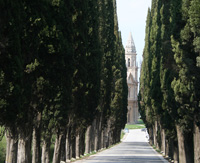
|
Perugia |
|
Massa Marittima |
|
San Biagio, Montepulciano |
| |
|
|
|
|
|
|
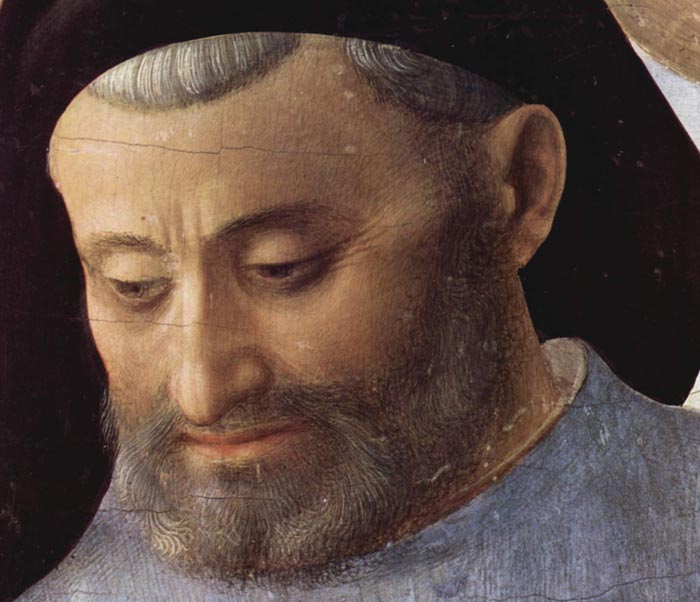
 This face in the "Deposition of Christ" is thought to be a self portrait of Fra Angelico.
This face in the "Deposition of Christ" is thought to be a self portrait of Fra Angelico.